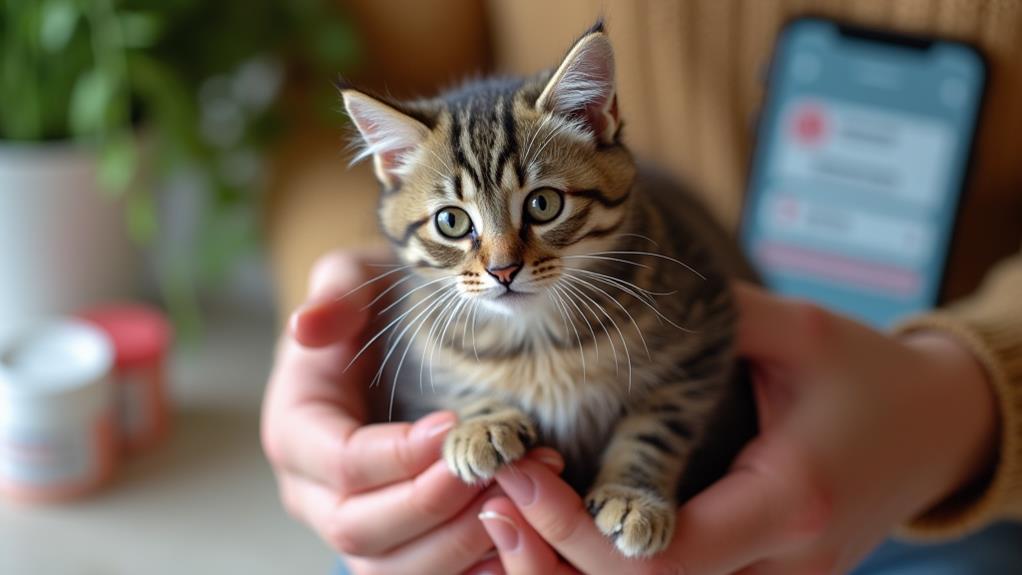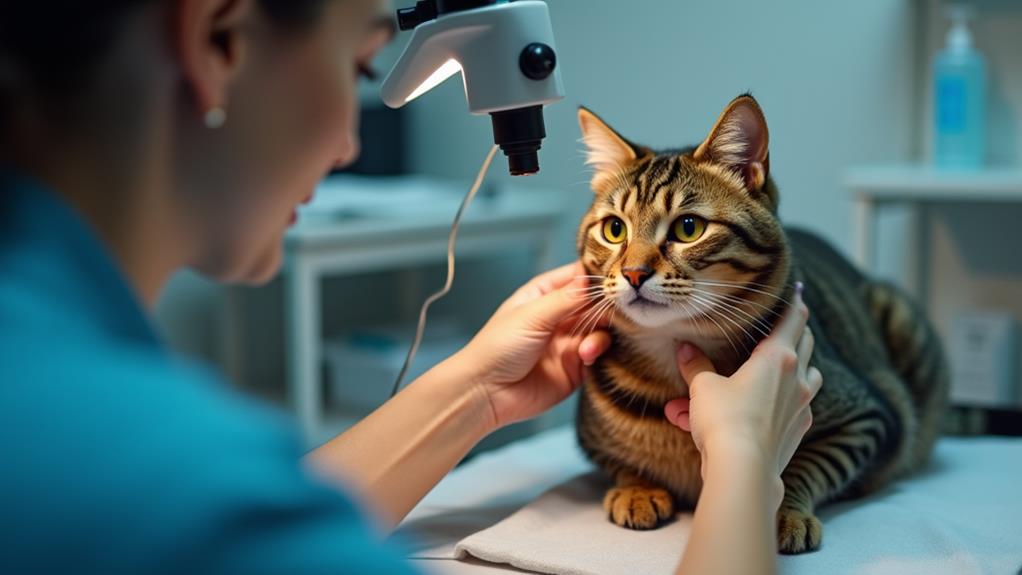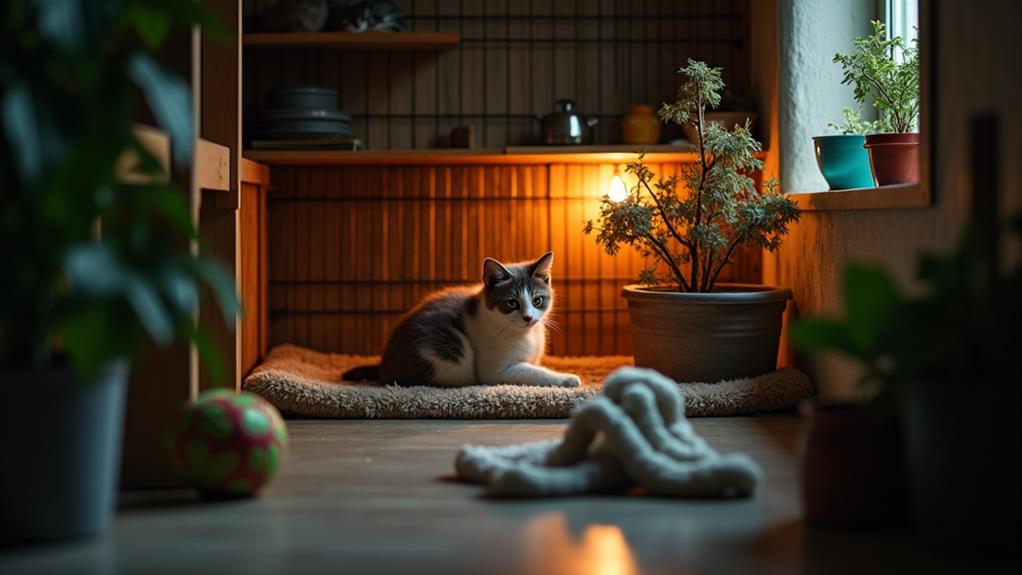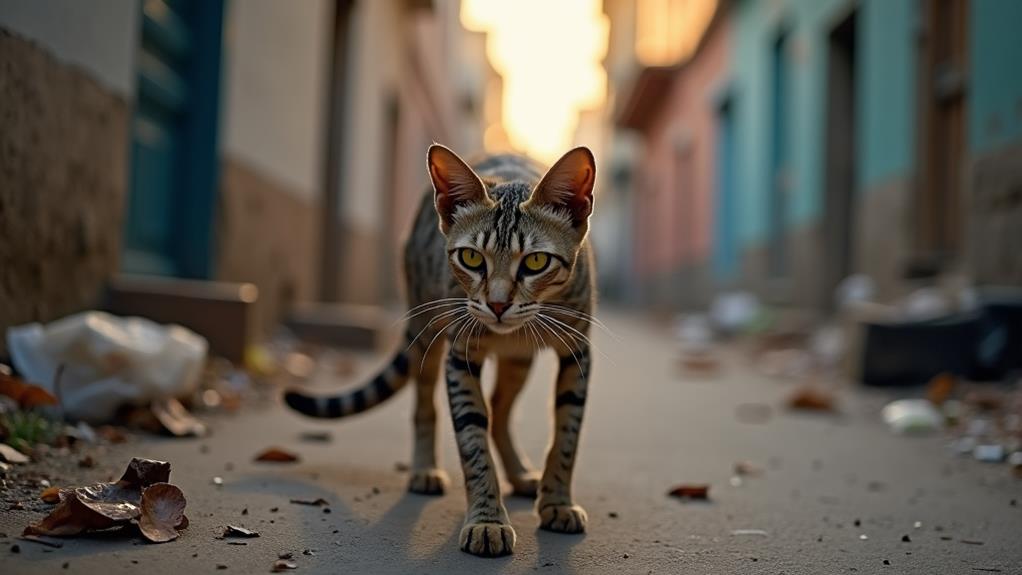How to Treat a Feral Cat's Eye Infection: Home Care and Vet Treatment

To treat a feral cat's eye infection, start by providing a calm environment to ease stress. Clean the cat's eyes with a cotton ball dipped in warm water, using an antimicrobial eye wash 3-4 times daily. Feed high-quality food and consider lysine supplements for viral issues. Avoid human medications; they're unsafe for cats. Seek veterinary help for proper diagnosis and necessary treatments like antibiotics or surgery if severe. Handling feral cats can be challenging, so use humane traps for safe capture. Professional care is essential for preventing complications. Uncover more about these techniques and support options.
Recognizing Eye Infection Symptoms
Spotting the signs of an eye infection in feral cats is vital for their well-being. You need to watch for common symptoms, such as redness of the eye, excessive tearing, or discharge. These signs often indicate an ongoing infection. Feral cats are particularly prone to feline conjunctivitis, which presents with watery or gooey eyes. If left untreated, this condition can lead to severe complications. Pay attention to any swelling around the eyes or squinting, as these can signal irritation or discomfort.
In some cases, sneezing or nasal discharge may accompany the eye symptoms, pointing to a possible upper respiratory infection. This can make the eye condition worse if not addressed promptly. Observing excessive blinking or squinting can further help you determine if the cat is in pain, indicating the need for immediate treatment.
Early recognition of these symptoms is vital to prevent escalation. Untreated eye infections might lead to more serious issues like potential blindness. By noticing these signs quickly, you can take steps to provide the necessary care and treatment, ensuring the feral cats have a better chance of recovery and maintaining their eye health.
Home Care Techniques
Effective home care techniques are essential for managing a feral cat's eye infection. Start by using Vetericyn Plus Antimicrobial Eye Wash to clean the affected eyes. Flush them 3 to 4 times daily, which helps alleviate symptoms of conjunctivitis. Regularly clean away any discharge using a cotton ball dipped in warm water. This gentle approach prevents further irritation and keeps the eyes as comfortable as possible.
It's significant to monitor the cat's condition closely over a 10-14 day period. Keeping a close eye on their progress allows you to assess the effectiveness of your home treatments and make necessary adjustments. Adding lysine supplements to their routine can be advantageous, as they help manage herpes virus outbreaks that often contribute to eye infections in feral cats.
To support their overall well-being and improve your ability to provide consistent treatment, establish a routine feeding program. This makes it easier to monitor the cat's health, including eye conditions, and guarantees they receive the nutrients they need. With these home care techniques, you can play an essential role in alleviating the discomfort of a feral cat's eye infection and supporting their recovery.
Veterinary Treatment Options

When dealing with a feral cat's eye infection, many veterinary treatment options can effectively address the issue. The process usually begins with a thorough examination to guarantee an accurate diagnosis. Understanding the specific cause of the eye infection allows the vet to prescribe the most effective treatment. Common prescriptions include topical antibiotics like Terramycin® or Vetropolycin®, which are applied directly to the eye. If the infection is due to underlying bacteria, oral antibiotics might be necessary to clear it up.
In cases of conjunctivitis or other inflammatory conditions, veterinarians may also recommend corticosteroid drops to reduce inflammation and irritation. These treatments help soothe the affected eye and promote healing. Utilizing mobile veterinary services can be particularly advantageous for feral cats, as it avoids the stress of capturing them for clinic visits. This approach provides necessary care in a more comfortable environment for the animal.
Regular veterinary services are essential for ongoing health management of feral cats. Consistent visits guarantee vaccinations and spaying/neutering are up to date, reducing the risk of future infections. With the right veterinary treatment plan, you can notably improve a feral cat's eye health and general well-being.
Challenges in Treating Feral Cats
Capturing feral cats for treatment presents significant challenges due to their natural distrust of humans and the stress that handling causes. This stress can exacerbate health issues like eye infections, making treatment even more difficult. Feral cats aren't accustomed to human interaction, so you need specialized capture techniques, like humane traps, to safely secure them for veterinary care. Unlike stray cats, feral cats are typically more skittish, complicating efforts to monitor and administer necessary treatments.
Once captured, accessing veterinary care for a feral cat's eye infection can be problematic. Limited resources and services often mean that many feral cats go without proper treatment, leading to persistent health issues. You might find that community feeding programs serve as a temporary measure to monitor these cats' health, but they can't replace the crucial role of professional intervention. Regular feeding can help build some level of trust, making it slightly easier to handle feral cats when treatment is necessary.
However, the sheer number of feral cats in certain areas can overwhelm available resources, making it difficult to provide thorough care for eye infections and other health problems. Balancing humane treatment with practical realities remains a significant challenge.
Community Support and Involvement

In many neighborhoods, community support and involvement are fundamental for managing the health and welfare of feral cats. By participating in community feeding programs, you can help monitor these cats' health, allowing volunteers to spot early signs of eye infections. Quick identification leads to timely treatment, which is critical for their well-being. Implementing TNR (Trap-Neuter-Return) programs is another significant step. These programs not only control feral cat populations but also improve their general welfare, decreasing the incidence of health issues like eye infections.
Collaborating with local veterinarians is key to providing necessary spaying/neutering services. This partnership helps mitigate future health problems within feral cat colonies. Educational outreach is similarly important. Raising awareness about feral cat care encourages more people to support local initiatives, resulting in better outcomes for these animals.
Volunteer networks play a vital role in managing feral cat colonies. They organize health monitoring and coordinate TNR efforts. These networks often rely on fundraising to cover the costs of required veterinary care. Your involvement, regardless of whether through volunteering or supporting these efforts financially, is invaluable in ensuring that feral cats receive the care they need to thrive in your community.
Safe Use of Medications
Having a robust community network is just the beginning. Guaranteeing the safe use of medications is vital in treating a feral cat's eye infection. Human medications, like Neosporin, can be toxic, emphasizing the need for veterinary-prescribed treatments. Always consult a vet to confirm the medication is suitable for the cat's condition and health status. Here's a checklist to guide you:
- Topical Treatments: Use veterinary-approved options such as Terramycin® or Vetropolycin® for eye infections. They're specifically formulated for cats and reduce the risk of adverse reactions.
- Liquid Antibiotics: These can be mixed with wet food, making administration easier for feral cats. Follow the vet's dosage instructions to guarantee effectiveness and prevent resistance.
- Home Remedies: Consider Lysine supplements for conditions like feline herpesvirus, but use them cautiously. Always seek vet guidance to avoid potential interactions and side effects.
- Monitoring: Regularly check the cat's response to treatment. Effectiveness can vary depending on the underlying cause of the eye infection, so adjust the approach as needed under veterinary supervision.




